25 Types Of Cotyledon Succulents (With Pictures)
Cotyledon succulents are a group of plants native to South Africa and are widely appreciated for their attractive foliage and beautiful flowers. These plants come in various shapes, colors, and sizes and can be grown indoors or outdoors. This article will provide an overview of the 25 types of cotyledon succulents, their characteristics, and how to care for them.
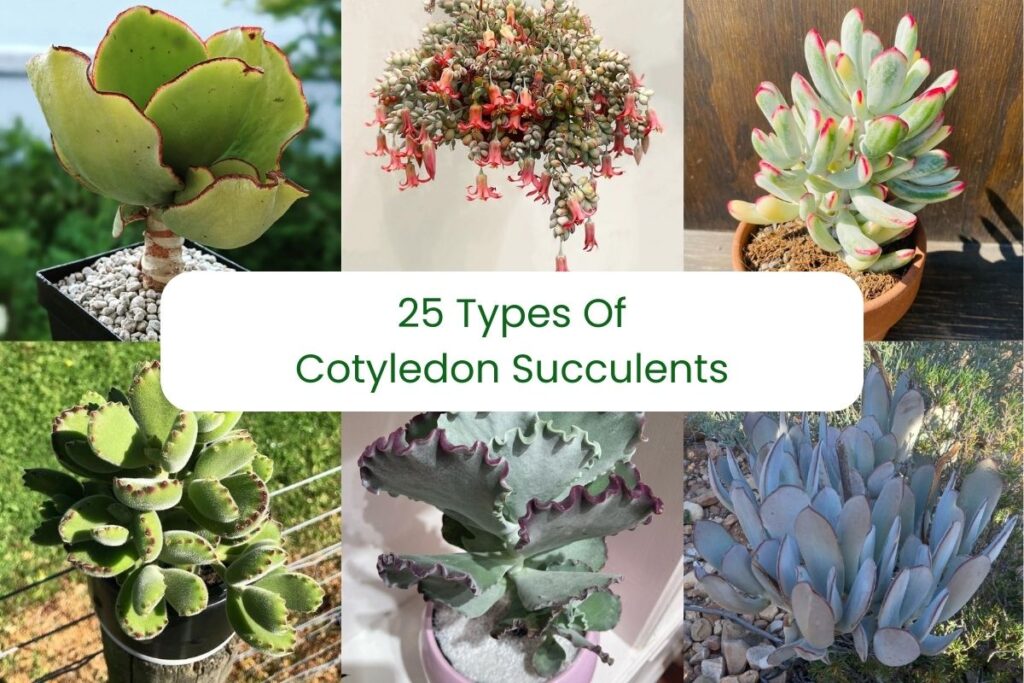
Contents
- 1 Types Of Cotyledon Succulents
- 1.1 Cotyledon adscendens
- 1.2 Cotyledon barbeyi
- 1.3 Cotyledon campanulata
- 1.4 Cotyledon cuneata
- 1.5 Cotyledon egglii
- 1.6 Cotyledon eliseae
- 1.7 Cotyledon ‘Happy Young Lady’
- 1.8 Cotyledon orbiculata
- 1.9 Cotyledon orbiculata var. spuria
- 1.10 Cotyledon orbiculata var. dactylopsis
- 1.11 Cotyledon orbiculata var. flanaganii
- 1.12 Cotyledon orbiculata ‘Elk Horns’
- 1.13 Cotyledon orbiculata var. oophylla
- 1.14 Cotyledon orbiculata var. undulata
- 1.15 Cotyledon orbiculata f. takbok
- 1.16 Cotyledon orbiculata var. oblonga
- 1.17 Cotyledon orbiculata var. oblonga ‘Macrantha’
- 1.18 Cotyledon orbiculata ‘Silver Storm’
- 1.19 Cotyledon papillaris
- 1.20 Cotyledon pendens
- 1.21 Cotyledon tomentosa
- 1.22 Cotyledon tomentosa subsp. ladismithiensis
- 1.23 Cotyledon velutina
- 1.24 Cotyledon woodii
- 1.25 Cotyledon xanthantha
- 2 How To Care For Cotyledon Succulents
- 3 How To Propagate Cotyledon Succulents
Types Of Cotyledon Succulents
Cotyledon adscendens
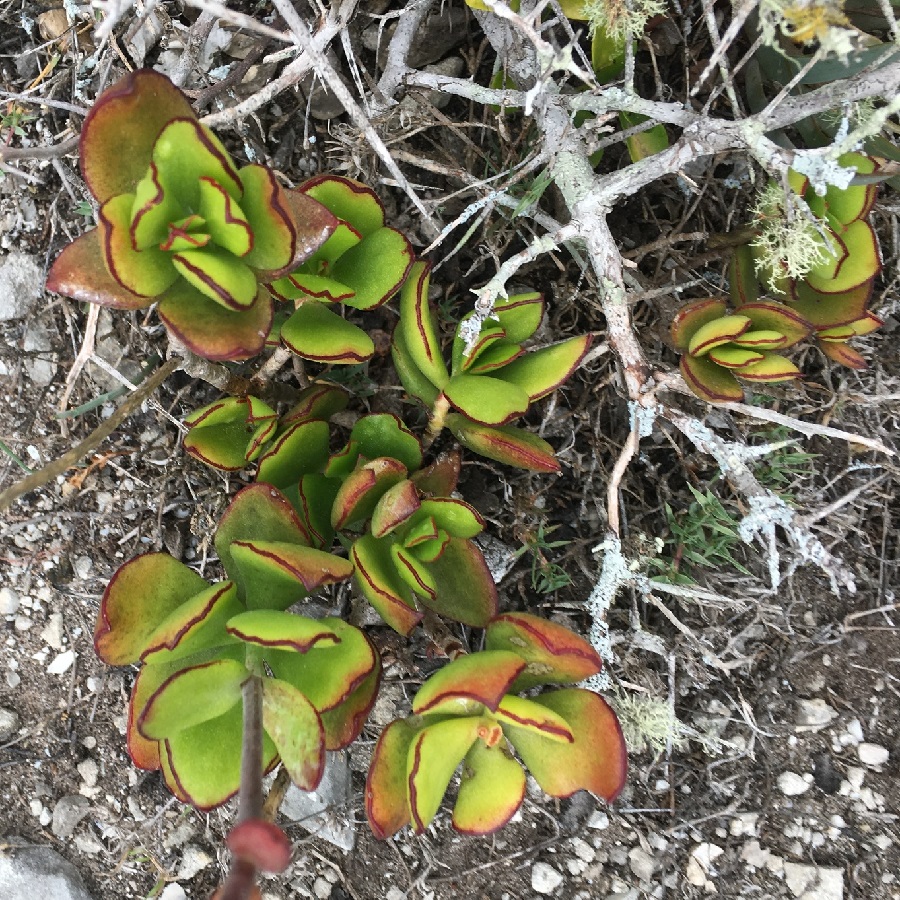
Cotyledon adscendens is a succulent species native to South Africa (Eastern Cape) that bears green leaves with reddish margins in the upper half. It grows up to 5.2 feet (1.6 m) tall and has obovate to spatulate, flat, slightly concave leaves up to 2.4 inches (6 cm) long and 1.1 inches (2.8 cm) wide. The orange-red flowers are tubular, up to 1 inch (2.5 cm) long and 0.4 inches (1 cm) in diameter and appear in clusters on a stalk of up to 14.4 inches (36 cm). This species is found in dune thickets and can be safely enjoyed from afar.
Cotyledon barbeyi
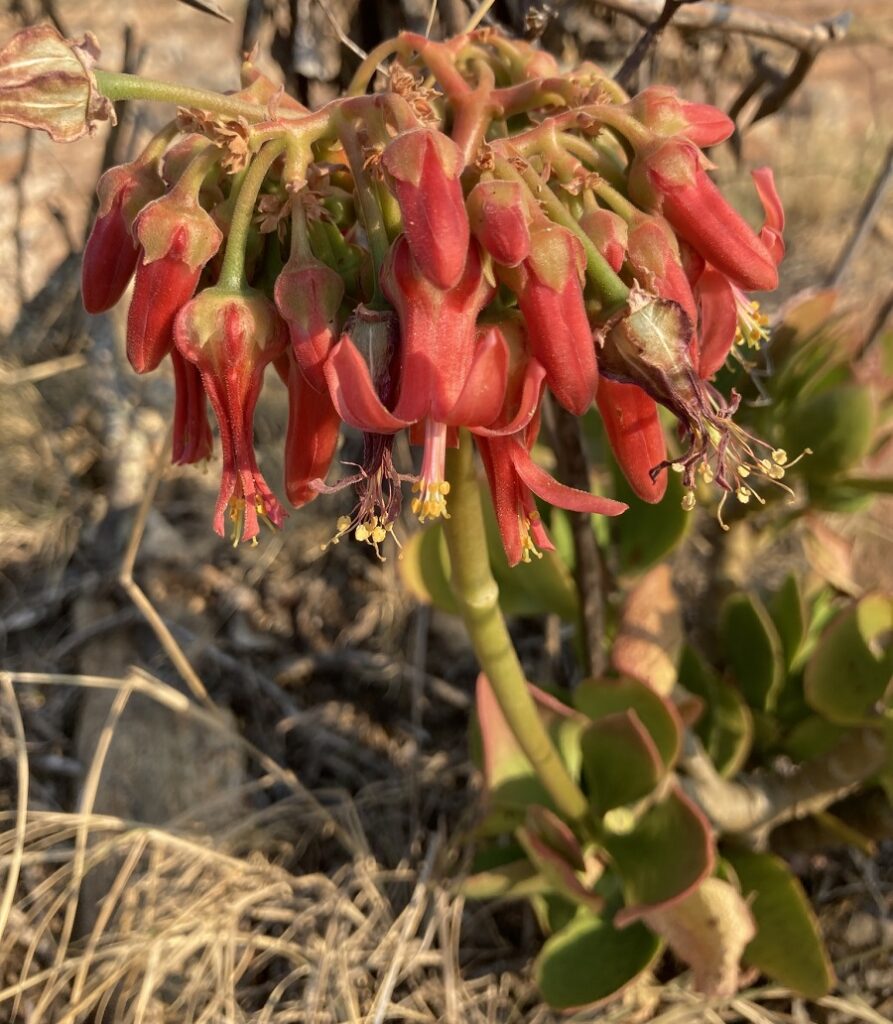
Bushveld cotyledon, Cotyledon barbeyi, is a robust perennial succulent herb that grows to a height of 1-2m. Its leaves are typically fleshy and vary in shape from ovate to lanceolate and linear. Pendulous red tubular flowers with a satiny sheen adorn the plant between March and September. It is easy to grow and has attractive shiny red flowers. Found naturally in woodland and scrub of Northern Province, Mpumalanga, Natal, Swaziland and Ethiopia, it is common in these areas.
Cotyledon campanulata
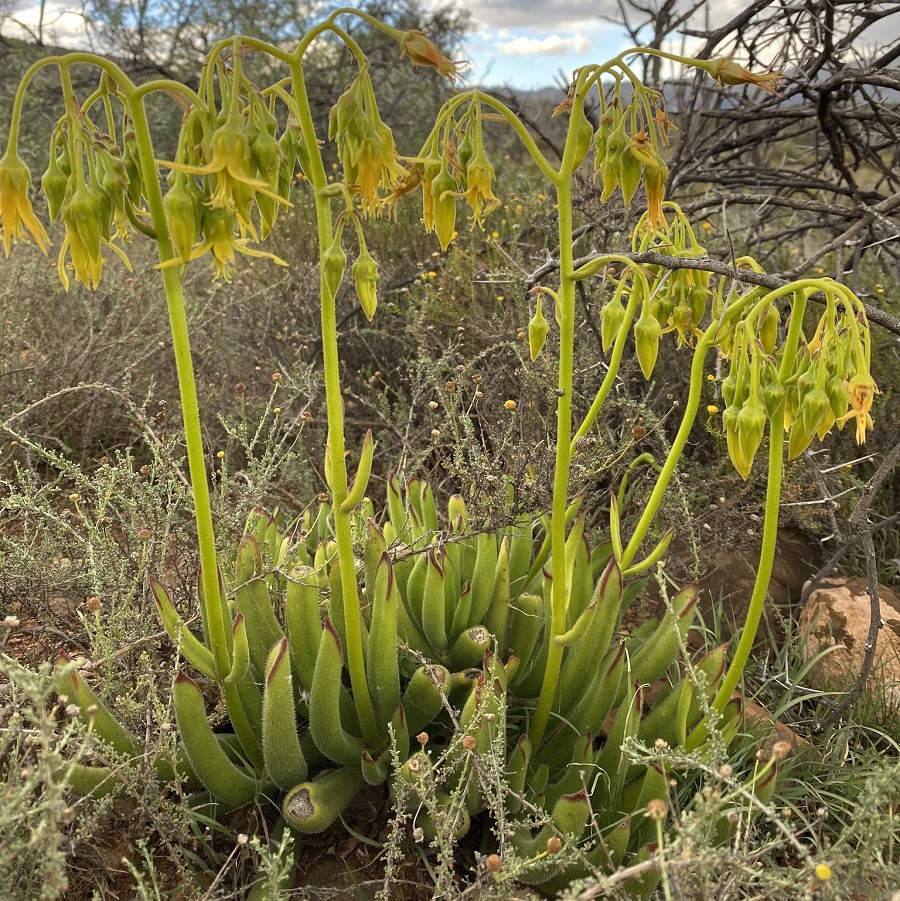
Campanulata is a succulent shrublet with spreading to decumbent branches and finger-like, finely hairy green to yellowish-green leaves. It grows up to 8 inches tall, much branched from the base, with opposite linear to lance-shaped leaves that are up to 5.2 inches long and 1.4 inches broad. Flowers appear on rect stalks in summer, yellow and reflexed petals on thyrse of 3 to 5 dichasia with 3 to 8 flowers each. Native to South Africa between Willowmore and Graaff-Reinet in Eastern Cape province, it can grow in USDA hardiness zone 9b – 11b (25°F – 50°F). Commonly called Bell Pigsear.
Cotyledon cuneata
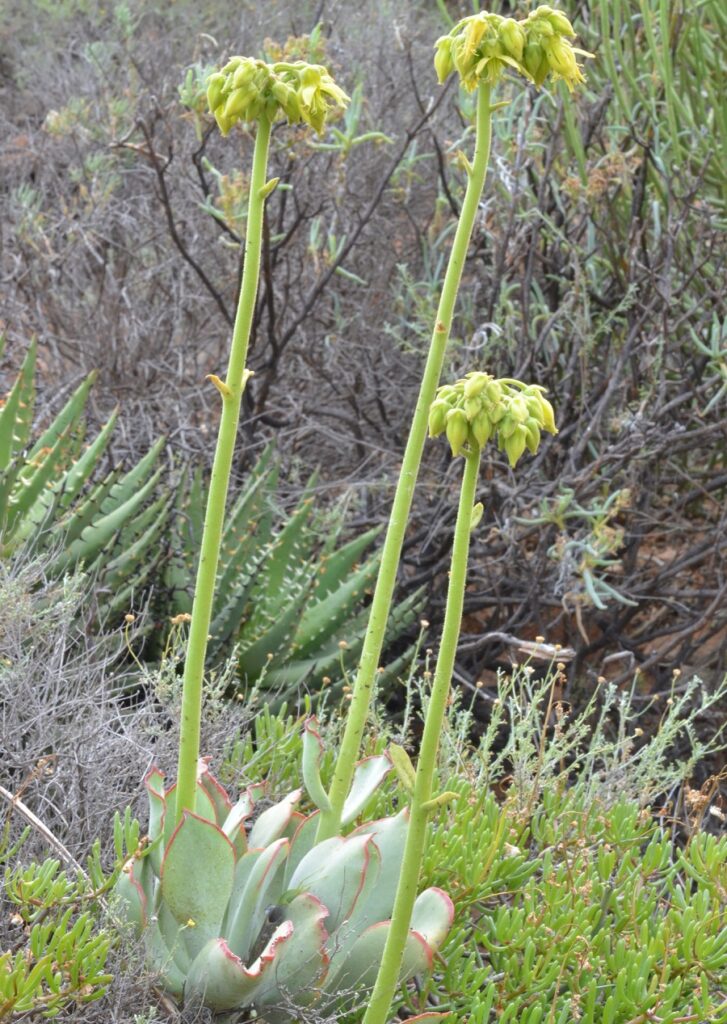
Cuneata is a perennial, decumbent shrub with variably colored flat leaves and yellow to yellow-green flowers in summer. Branches are short and spreading, robustly branching out near the base. Leaves are opposite, hispid, oblong-obovate, cuneate at the base and up to 17 cm long. Peduncles end in a spreading or condensed inflorescence with 3-5 dichasia and (3-)5-9 flowers each. Calyx lobes are triangular-lanceolate while corolla is viscid on the outside with a cylindrical to urceolate tube of 6-12 mm length. Anthers measure 3 mm long. Flowers bloom in November/December as the plant enters dormancy. This species is also known as ‘Sticky Pigs Ears’.
Cotyledon egglii
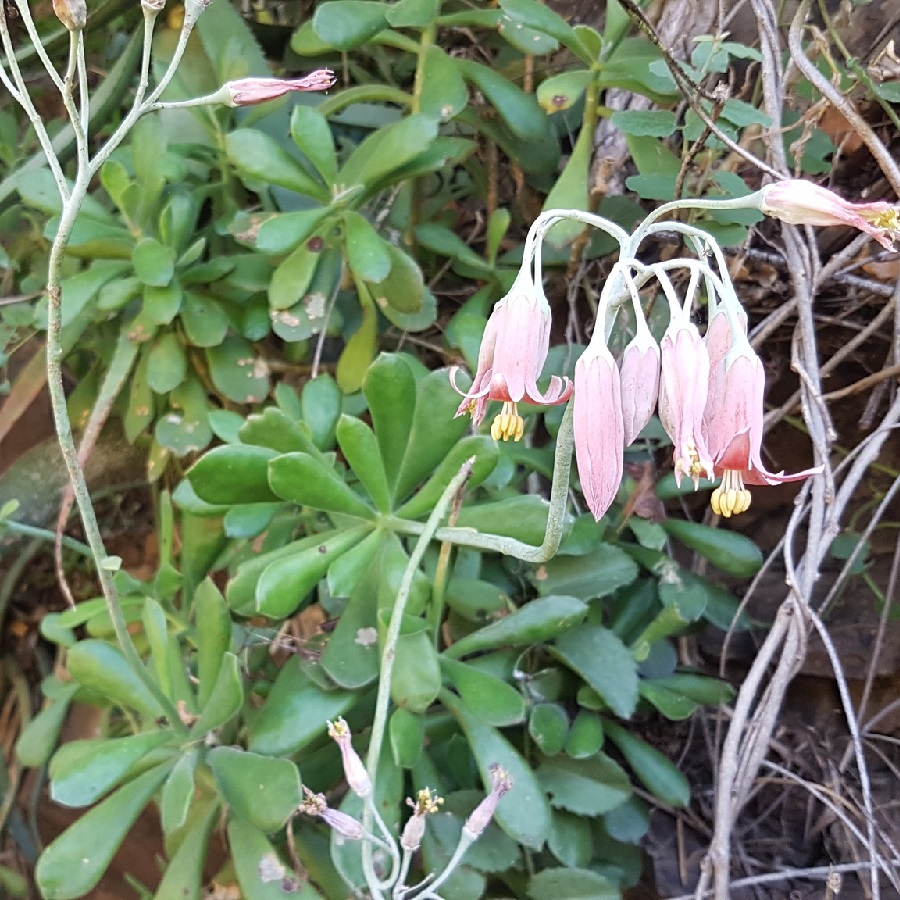
Easily grown, Cotyledon egglii is a succulent shrublet recognized by its wedge-shaped (cuneiform), green leaves and tubular, orange to dull orange flowers that bloom in autumn. It grows on steep rocky slopes and cliffs in the Savanna vegetation of the mountainous terrain of the Barberton Centre of Endemism, Mpumalanga. Its branches are 8-9 mm in diameter, grey-green with smooth, brownish bark becoming woody with age. The leaf margin tips are reddish with minutely hairy undulations while anthers are 1.5 × 1.5 mm and yellow. Carpels taper to slender styles 32–33 mm long and flower stalks 15–30 mm long. Pollinated by sunbirds, this species is known as Barberton pig’s ears.
Cotyledon eliseae
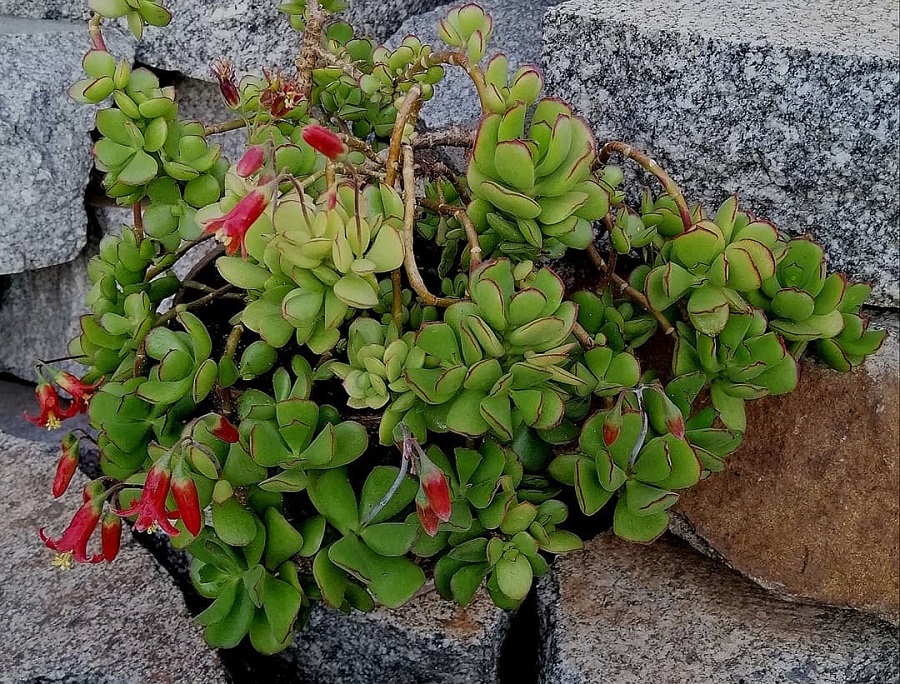
Described by Van Jaarsveld in 1997, Cotyledon eliseae is a compact, branched shrublet with long-lasting, showy orange-red flowers and rich green foliage. It stands at 20 cm tall and is distinguishable from the related Cotyledon woodii due to its sticky leaves and dwarf stature. Its branches measure 5 mm in diameter with obovate leaves of 1.5-3.4 cm long and 1-1.4 cm wide with convex faces.
The inflorescences are compound up to 9 cm long containing 1-3 dichasia while the pedicels reach 18 mm long. Sepals are 2.5 cm long with green-purplish markings and deep red corolla tubes 12 cm long with spreading lobes 15 mm long. Filaments measure 12 mm, white and flattened, anthers 1mm in diameter while nectaries spread ascendingly as square yellow fleshy bodies of 1 x 1mm each. This succulent blooms mid-summer providing safety for those who desire it through its beauty.
Cotyledon ‘Happy Young Lady’
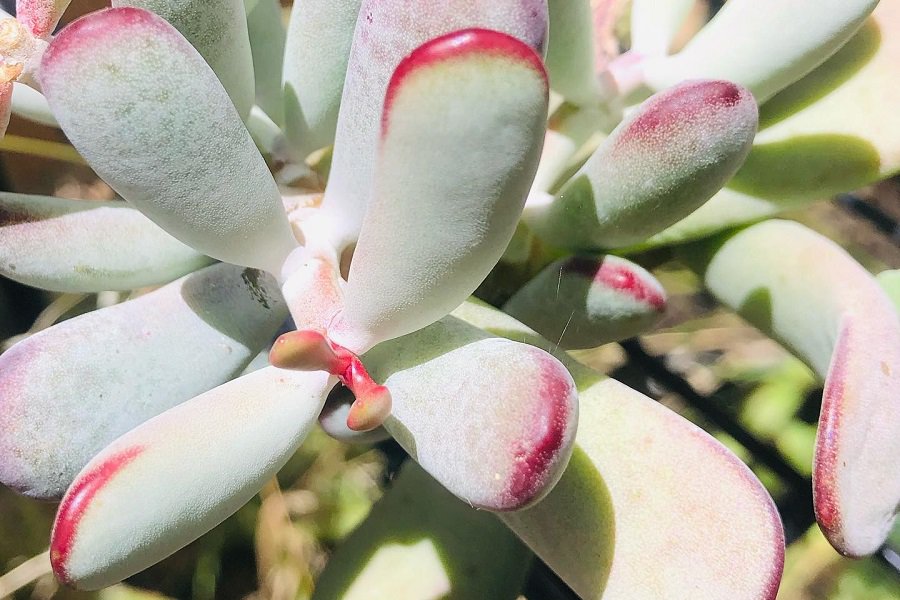
A hybrid of unknown parentage, ‘Happy Young Lady‘ is a dense succulent with grey-green to blue-green finger-like leaves on short fleshy stems, growing up to 12 inches (30 cm) tall. Leaves have a powdery white coating and maroon wedge-shaped tips. Its coral flowers are bell-shaped and appear in clusters on tall, slender stalks during summer and fall. It is hardy in USDA zones 9b to 11b; with temperatures between 25°F (-3.9°C) and 50°F (+10°C).
Cotyledon orbiculata
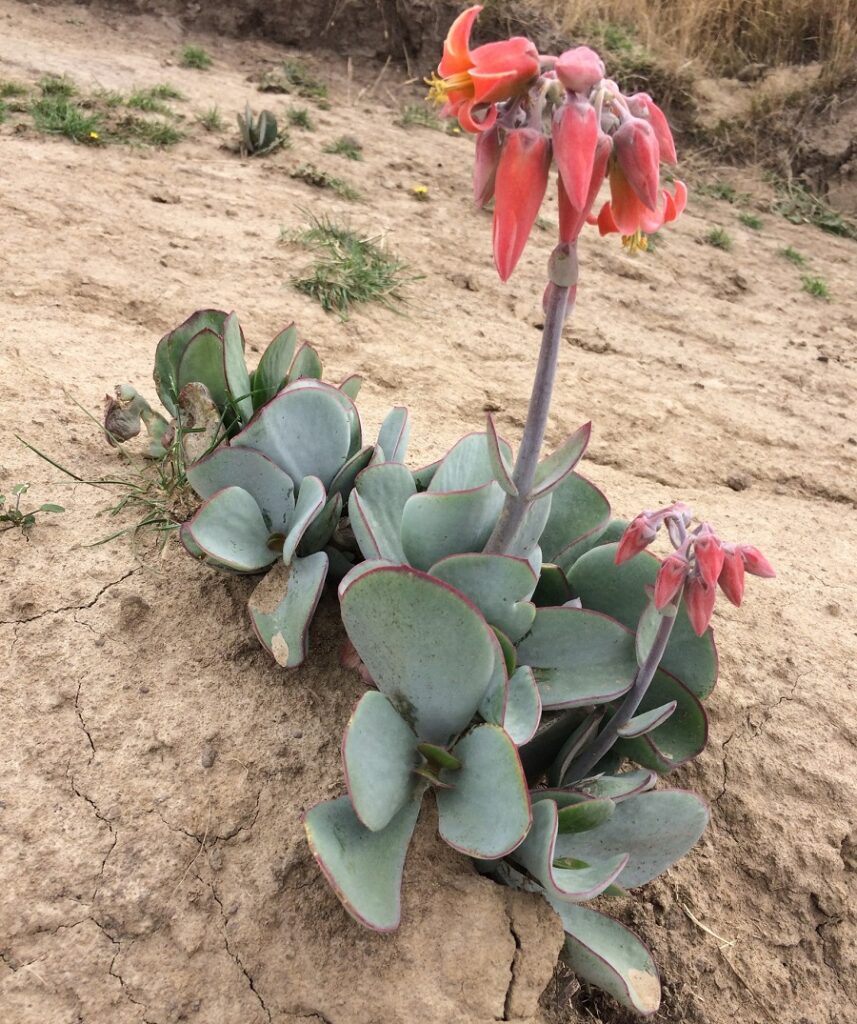
Cotyledon orbiculata is a species of succulent plant characterized by thick leaves in shades of green to grey, often with a red line around the margin. It has five varieties and is widespread throughout South Africa, usually found on rocky outcrops. Flowers are tubular/bell-shaped, mostly orange-red but yellow forms exist. Blooming is mostly from June-August in winter rainfall areas and midsummer elsewhere. Commonly known as pig’s ears, it tolerates moderate frost but not black frost if unprotected.
Cotyledon orbiculata var. spuria
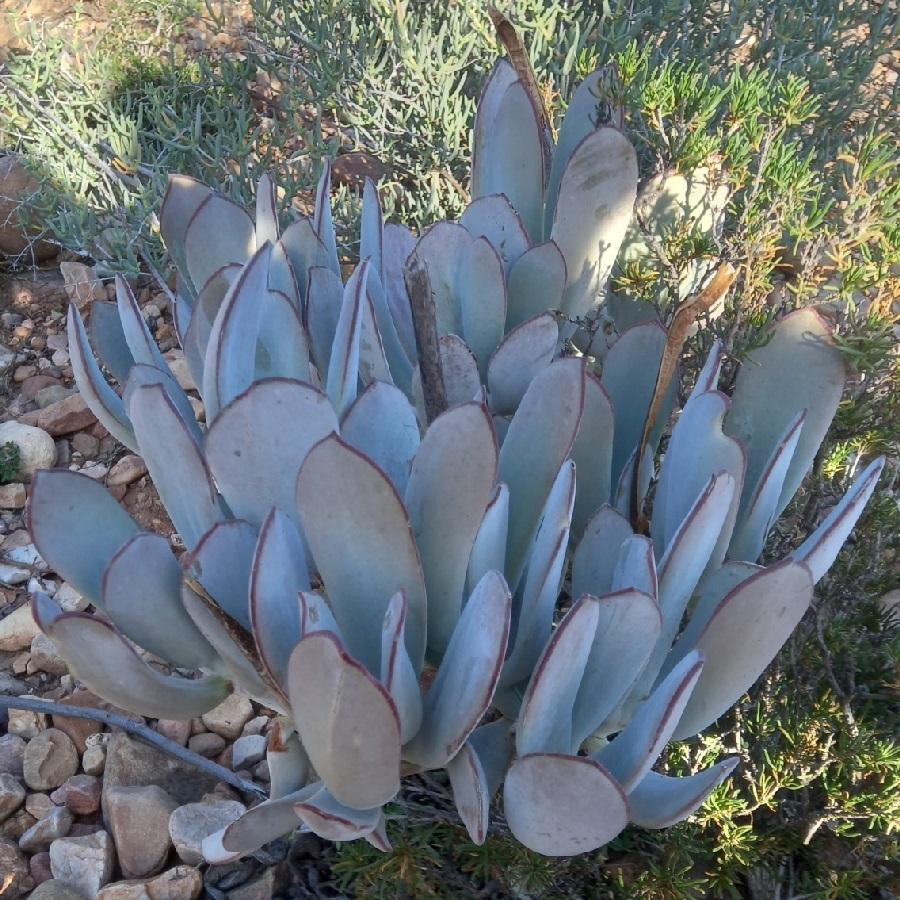
Variety spuria of Cotyledon orbiculata is distinguished by its five bract pairs on the stem of its inflorescence. Commonly known as Purple Pigs Ear, this succulent has a unique appearance and requires special care. To ensure safety, always wear gloves when handling it to avoid potential irritation and other undesired issues. Its foliage is usually a deep purple or blue-green color with white spots. This variety should be placed in bright indirect light to thrive, with occasional direct sun exposure for best results. Keep soil moist but not soggy for optimum health.
Cotyledon orbiculata var. dactylopsis
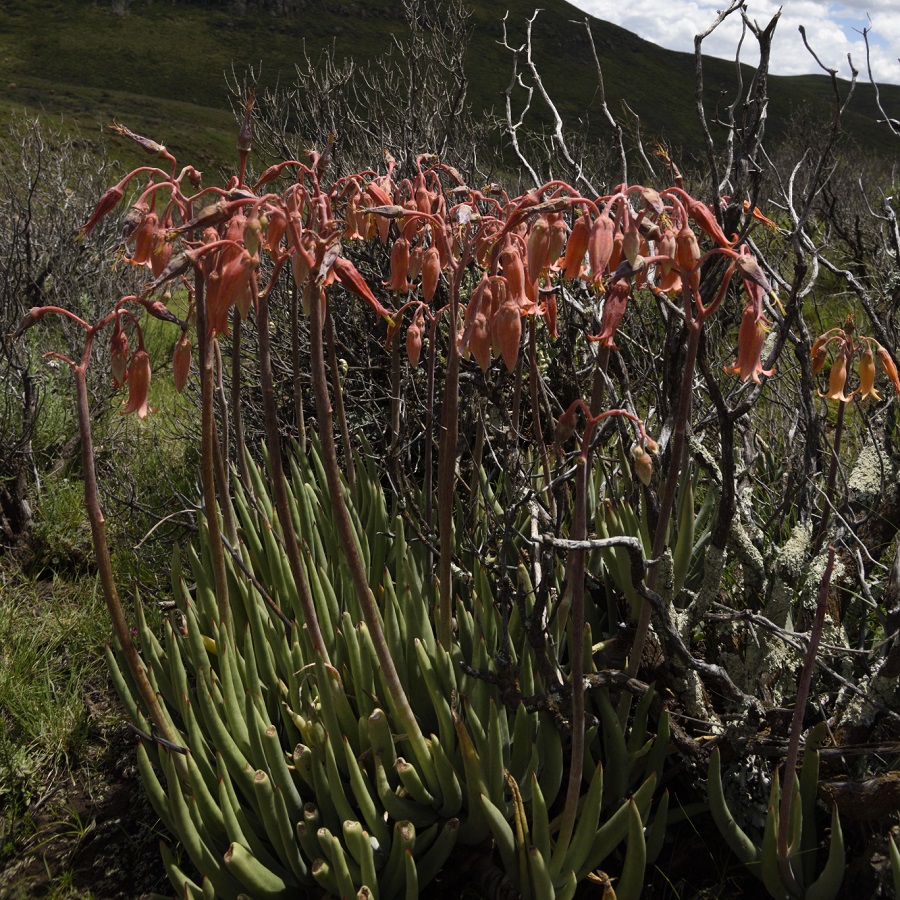
Distinguished by its three bract pairs on the stem of its inflorescence, Cotyledon orbiculata var. dactylopsis is a succulent commonly known as Finger Pigs Ear. It is characterized by elongated, terete leaves and can be found in many locations where it proliferates. This plant is considered safe for humans and animals alike, making it an ideal addition to any home or garden. Its ability to thrive in various climates makes it a great choice for those looking to add some greenery to their space without needing much maintenance.
Cotyledon orbiculata var. flanaganii
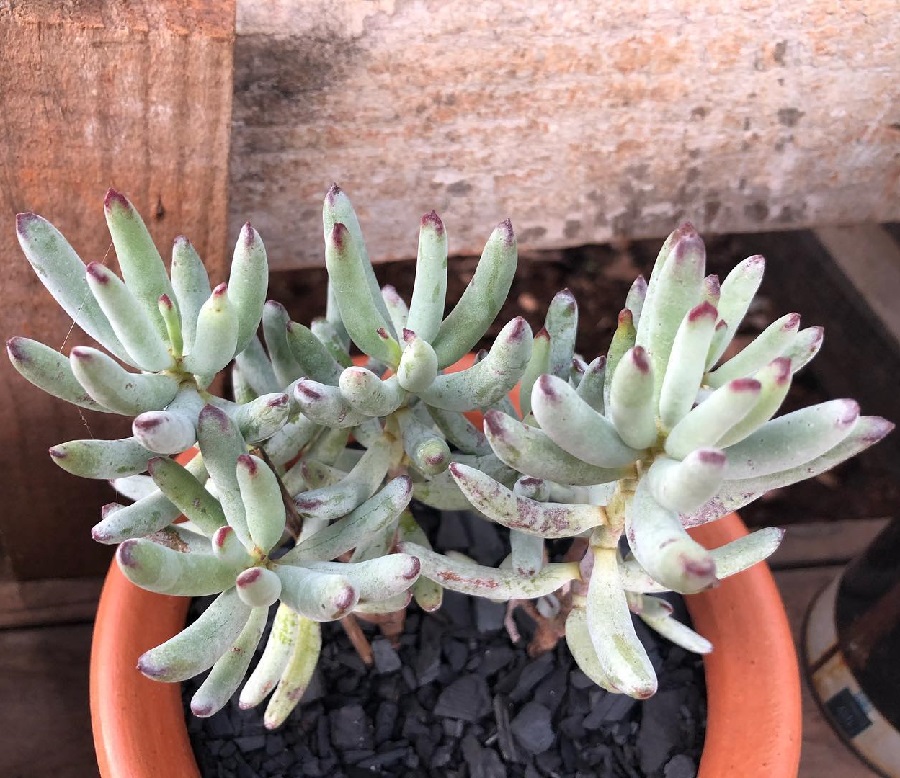
Another variety of Cotyledon orbiculata, known as Flanagan’s Pigs Ear, has elongated leaves in whorls. It is an evergreen succulent that grows to a height of up to 2 feet and its leaves are thick and fleshy. This plant is drought tolerant and can thrive with minimal water needs. It requires full or partial sun exposure with well-drained soil for optimum growth. The vibrant leaves appear in shades of green, blue-grey or silver-grey depending on the amount of sunlight it receives. The leaves form a rosette shape along the top part of the stem which makes it an attractive addition to any garden or home landscape.
Cotyledon orbiculata ‘Elk Horns’
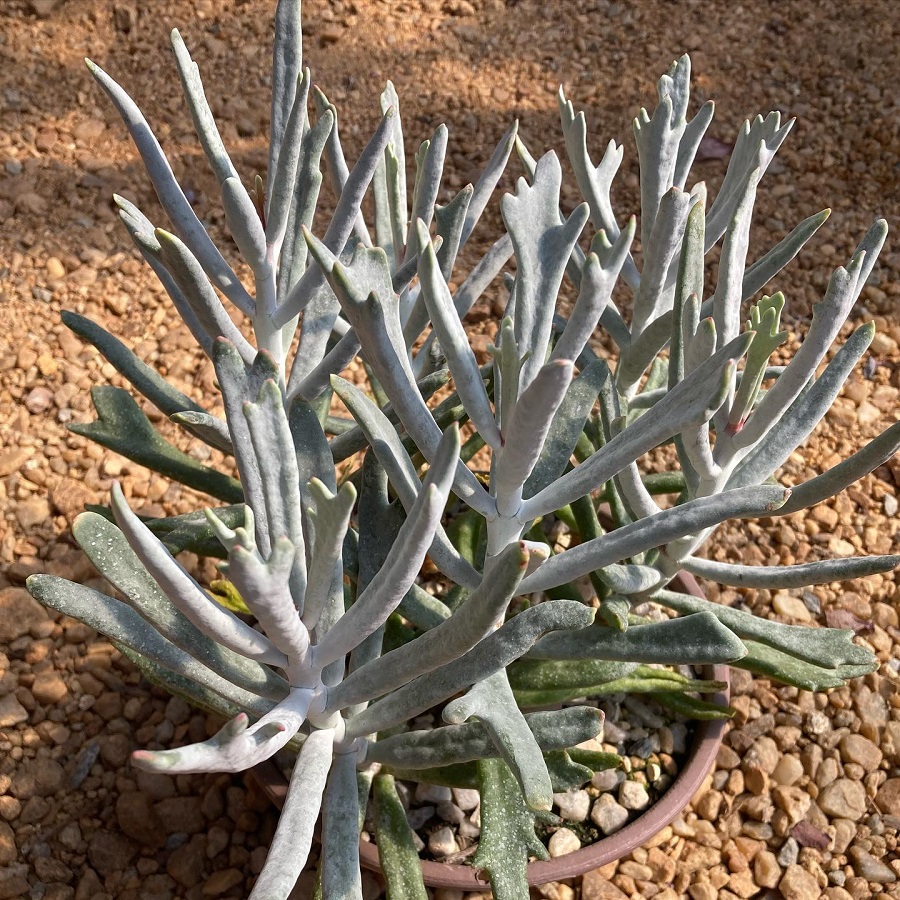
Cotyledon orbiculata ‘Elk Horns’ (also called ‘Staghorn‘) is a distinctive succulent with flat, multi-pronged leaves resembling elk antlers. It grows up to 12 inches (30 cm) tall and 18 inches (45 cm) wide. This variety has powdery silver-white leaves that are round first and then become flat. It can survive in USDA hardiness zones 9b to 11b, temperatures between 25 °F (−3.9 °C) and 50 °F (+10 °C).
Cotyledon orbiculata var. oophylla
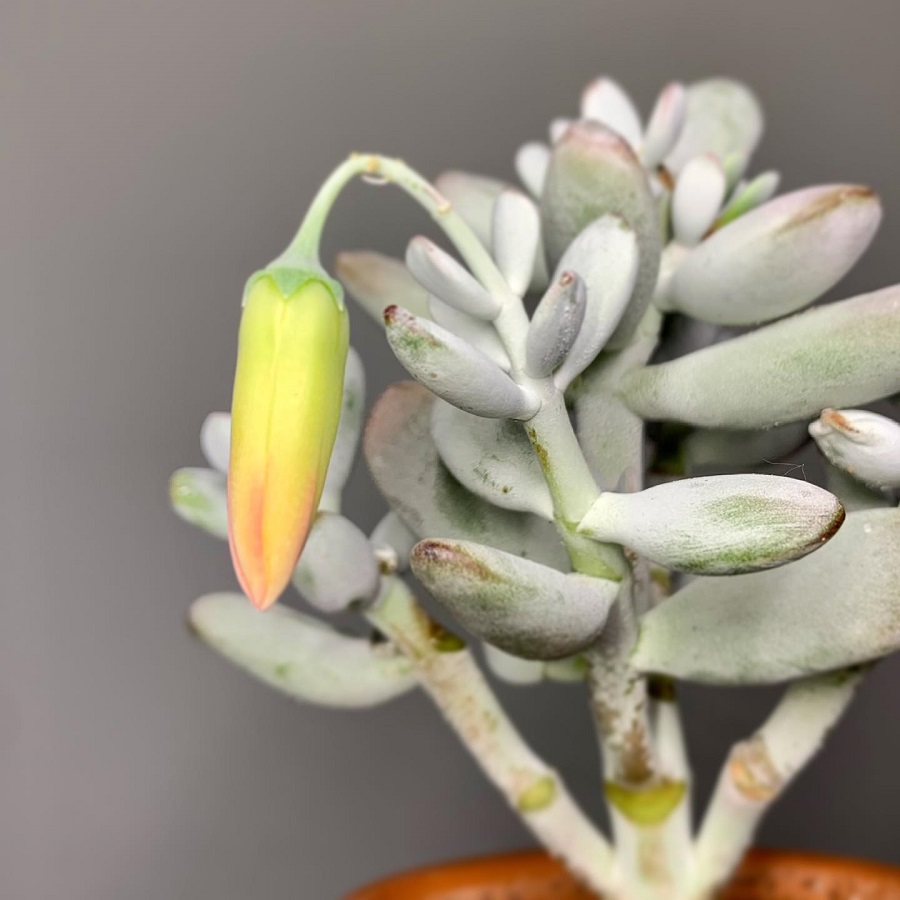
The popular cultivar Cotyledon orbiculata ‘Oophylla’ is a subshrub with branched stems topped by grey-green leaves. They have a white, waxy covering and a dark purple mark at their rounded tip. Clusters of orange-red flowers appear in winter on short erect stalks above the foliage, typically 0.8 inches (2 cm) long. It originates from South Africa and Namibia and is suitable for USDA hardiness zones 9b to 11b. Commonly known as Lady Fingers or Round-leafed Navel Wort, it makes an attractive addition to any garden.
Cotyledon orbiculata var. undulata
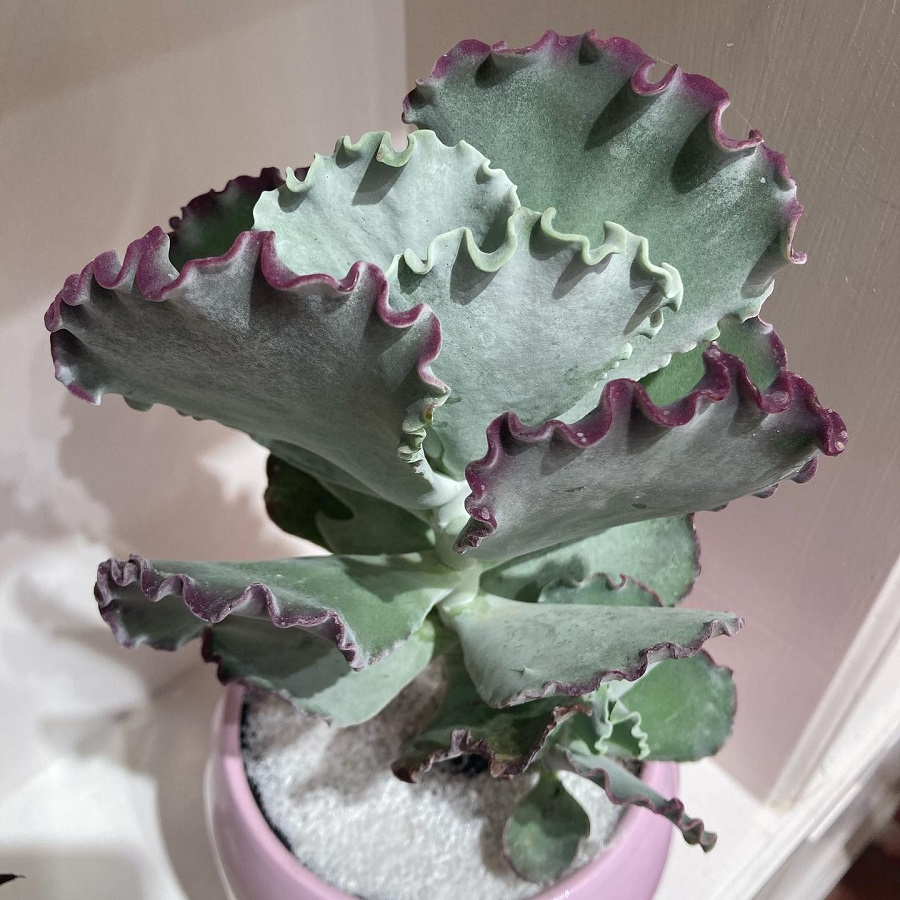
Variety undulata of Cotyledon orbiculata is a small, neat and tidy succulent shrub with unusual grey undulating leaves. It is up to 50 cm in height with thick, white coating stems. The leaves are shaped like scallop shells and have a powdery waxy coating over them. The flowers are orange-yellow in color. Commonly known as Silver Crown or Silver Ruffles, this plant is widely grown for its sculptural shape.
Cotyledon orbiculata f. takbok
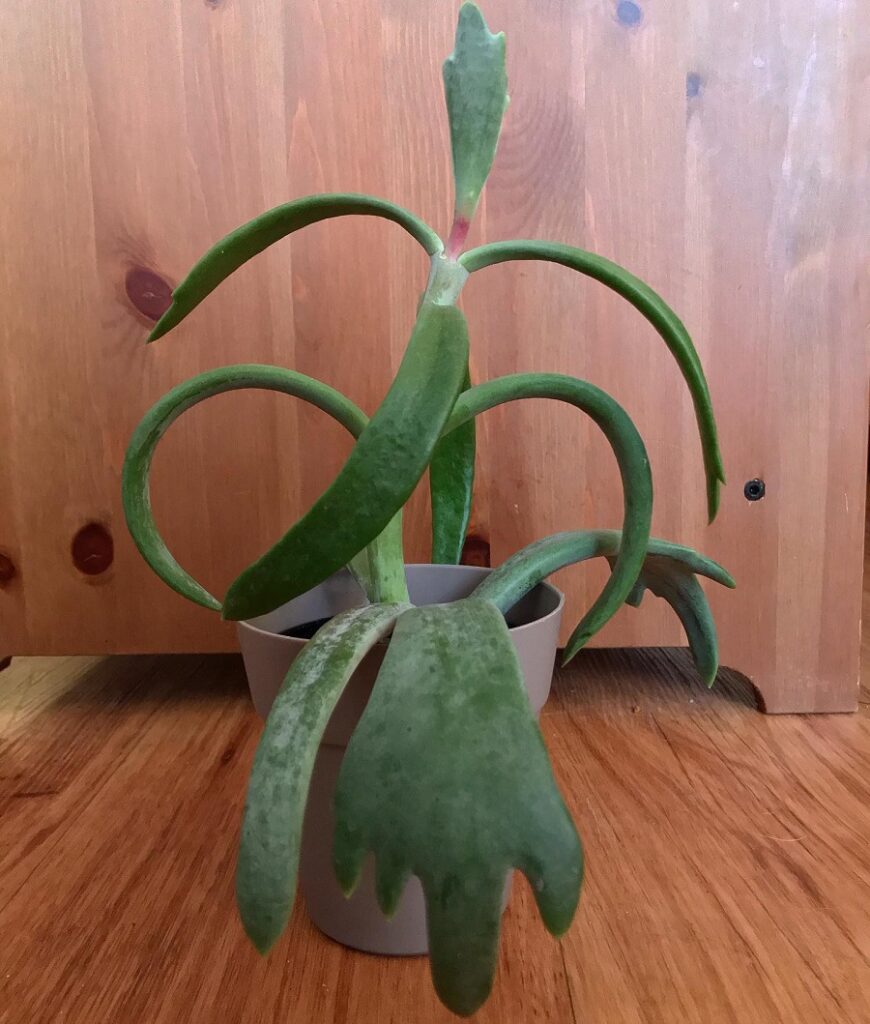
Cotyledon orbiculata var. oblonga ‘Takbok’ is a succulent shrub with gray-green leaves that develop antler-like lobes when exposed to sunlight. It produces orange, bell-shaped flowers from winter to spring on erect stalks up to 12 inches tall. The cultivar name ‘takbok’ is an African word meaning ‘the branched antlers of a buck’, referring to the shape of the leaves. This plant provides both interesting foliage and attractive blooms for gardeners seeking safety in their outdoor areas.
Cotyledon orbiculata var. oblonga
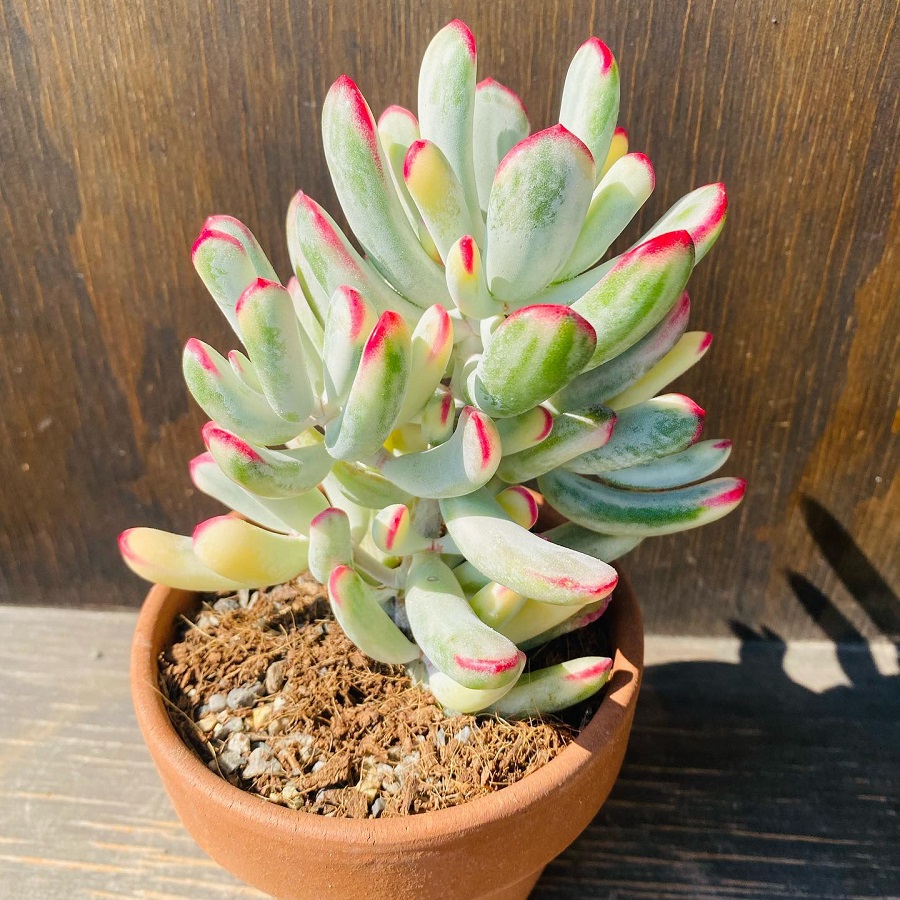
Described as a succulent shrub with closely packed leaves along decumbent branches, Cotyledon orbiculata var. oblonga is native to South Africa. It typically grows to around 32 inches tall and has obovate to oblanceolate-shaped leaves that are usually green or glaucous in color, with red margins at the apex. In winter and spring, it produces tubular flowers that can be red to pinkish orange, or rarely yellow, up to 1.4 inches long and 0.6 inches in diameter.
This plant is found in grassland and open bushveld habitats associated with rock outcrops throughout the Eastern Cape, KwaZulu-Natal, Mpumalanga, Free State, North West, Gauteng and Limpopo provinces. Commonly known as Chalk Fingers or Long Fingers, this species is safe for most environments.
Cotyledon orbiculata var. oblonga ‘Macrantha’
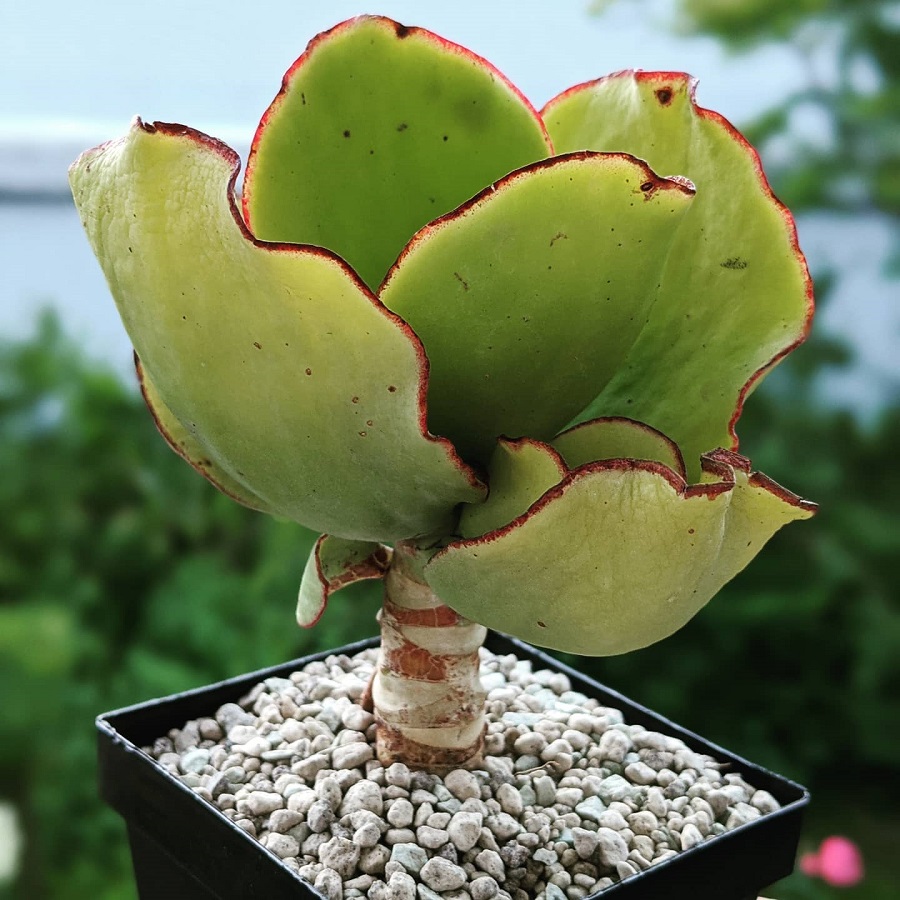
The cultivar Cotyledon orbiculata var. oblonga ‘Macrantha‘ is notable for its fleshy, paddle-shaped leaves edged with a thin red line and clusters of showy, bell-shaped, coral-red flowers in winter and spring. Growing up to 80 cm tall, this succulent shrub is attractive even when not blooming. It is an ideal choice for those seeking to add beauty and safety to their garden or home landscape.
Cotyledon orbiculata ‘Silver Storm’
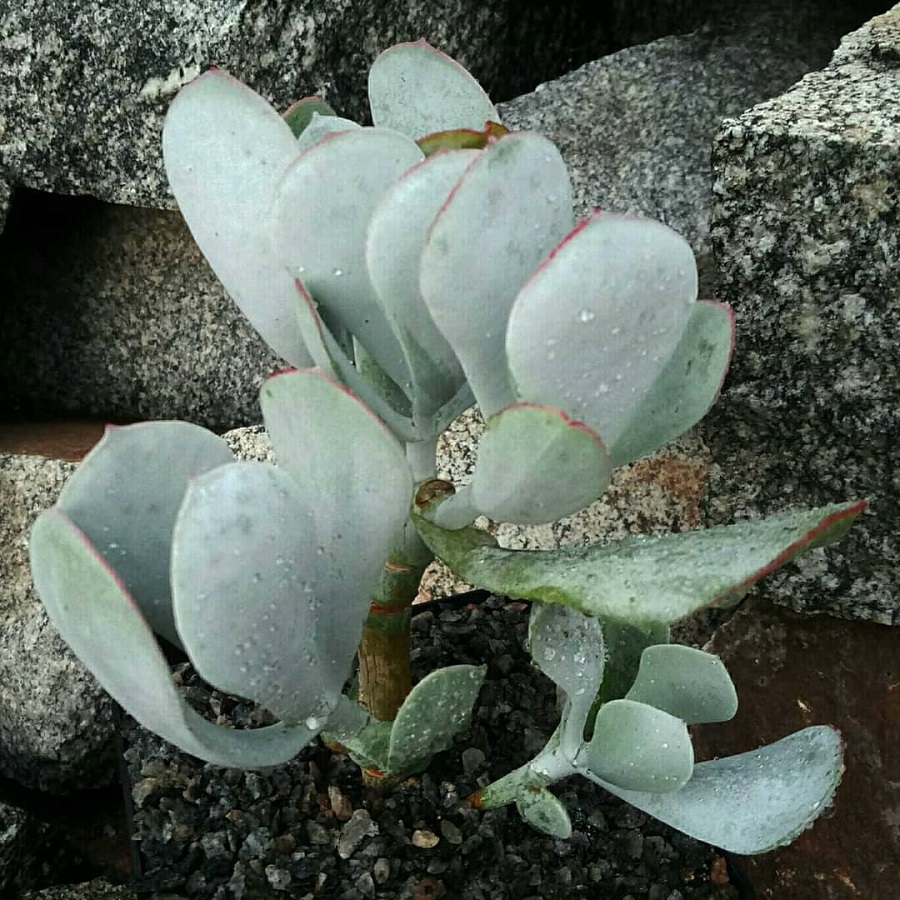
A cultivar of Cotyledon orbiculata, ‘Silver Storm‘ is distinguished by its greenish-grey leaves with red-edged margins and orange flowers in panicles on long stalks. It is native to South Africa and has thick leaves that can range from green to grey. It can be mat-forming or clump forming, or grow into small to medium shrubs. This succulent is an excellent choice for those looking for something unique and safe to add to their garden.
Cotyledon papillaris
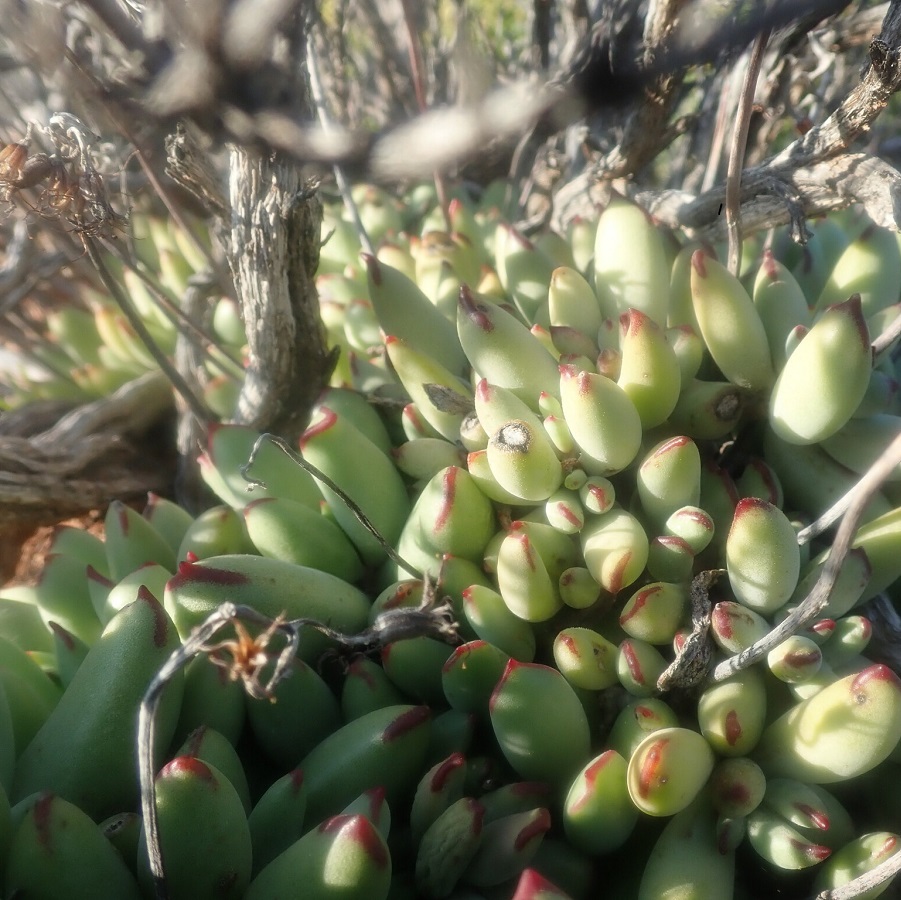
Cotyledon papillaris is a spreading shrublet with decumbent to procumbent branches that often root when touching the soil. It grows up to 10 cm tall and has yellowish-green to glaucous leaves, measuring up to 6 cm long and 1.3 cm wide. Flowers of this succulent are bell-shaped, yellowish to orange-red, and grow on stalks up to 25 cm tall from late spring until summer. Commonly known as Sprawling Pigs Ears, Cotyledon papillaris is a safe species for cultivation in a home garden setting.
Cotyledon pendens
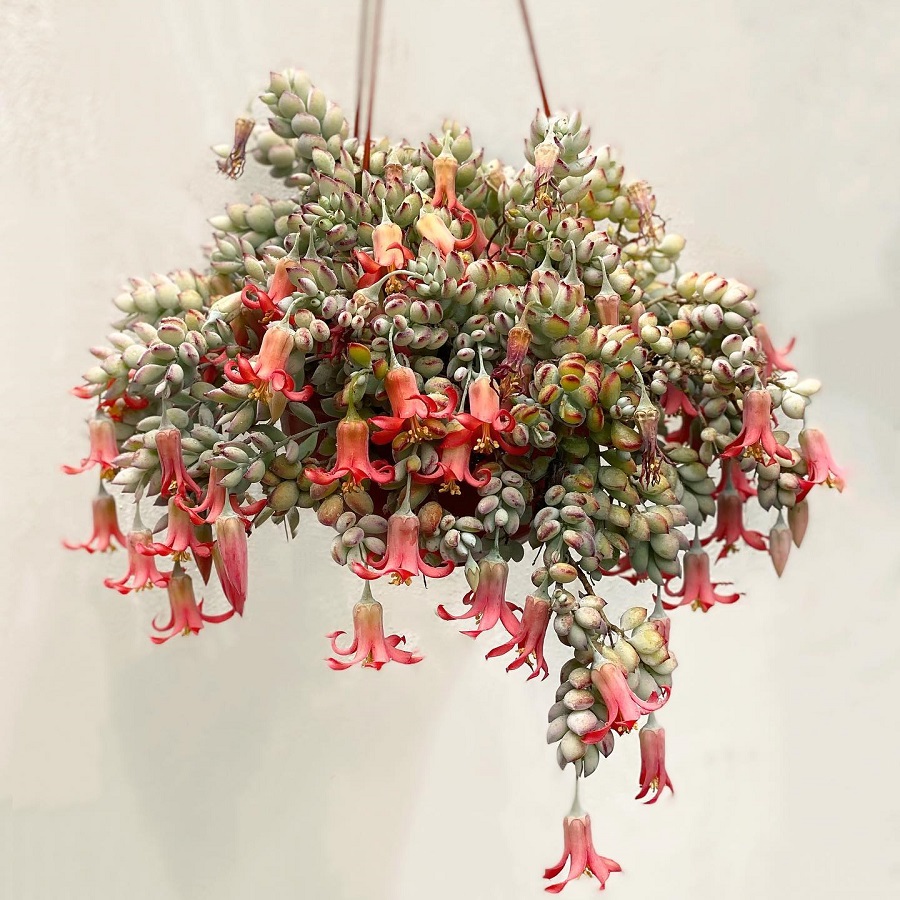
Characterized by pendent growth habit, Cotyledon pendens is a much-branched succulent shrublet with teardrop-shaped leaves that are highly succulent, green with reddish margins. The stems can grow up to 2 feet long and become more woody as they age. During the summer, orange-red flowers appear which have a cylindrical tube and spreading petals. Native to South Africa, C. pendens grows in sheer cliff faces along the Mbashe River in the Eastern Cape province. It is an important plant species for its potential medicinal use as well as for ornamental purposes.
Cotyledon tomentosa
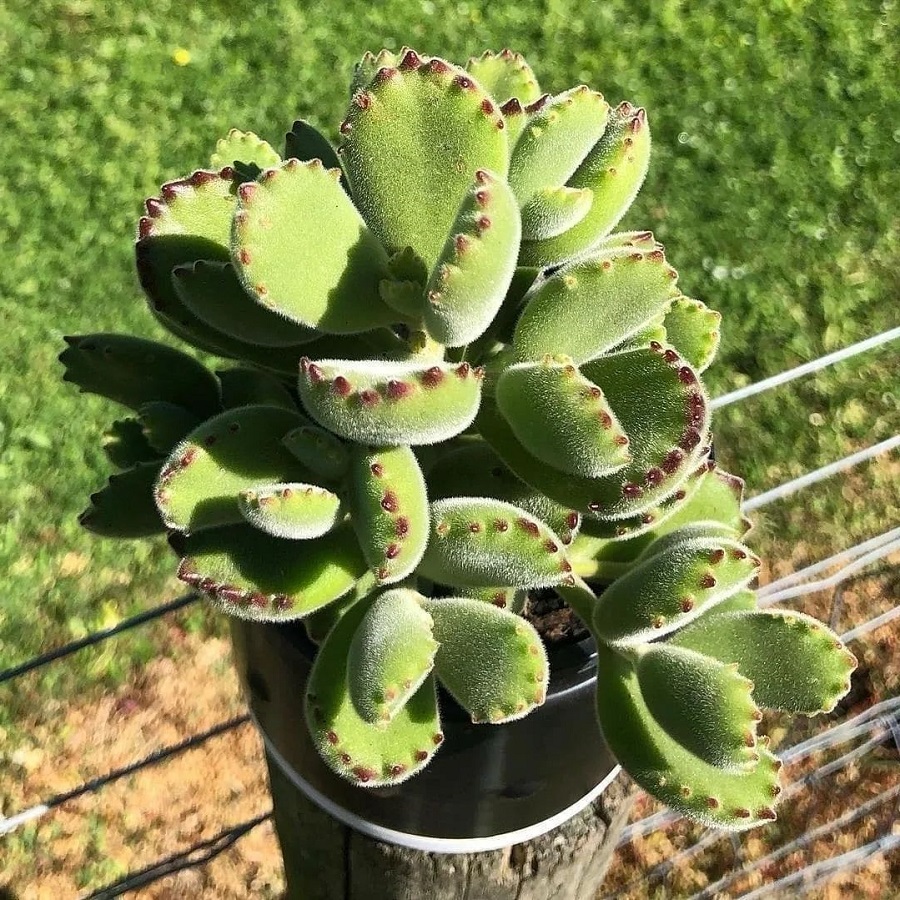
Tomentosa is a small, densely branched succulent shrub which produces bell-shaped flowers in spring. Its branches bear green to gray-green hairy leaves with 3 to 10 reddish to dark red teeth arranged in a row. Leaves are thick and fleshy, up to 2.6 inches long and 1.3 inches wide. The flowers can be light yellow, orange to orange-red or pinkish in color. Commonly known as Bear’s Paw, Cotyledon tomentosa is an attractive shrub that grows up to 20 inches tall.
Cotyledon tomentosa subsp. ladismithiensis
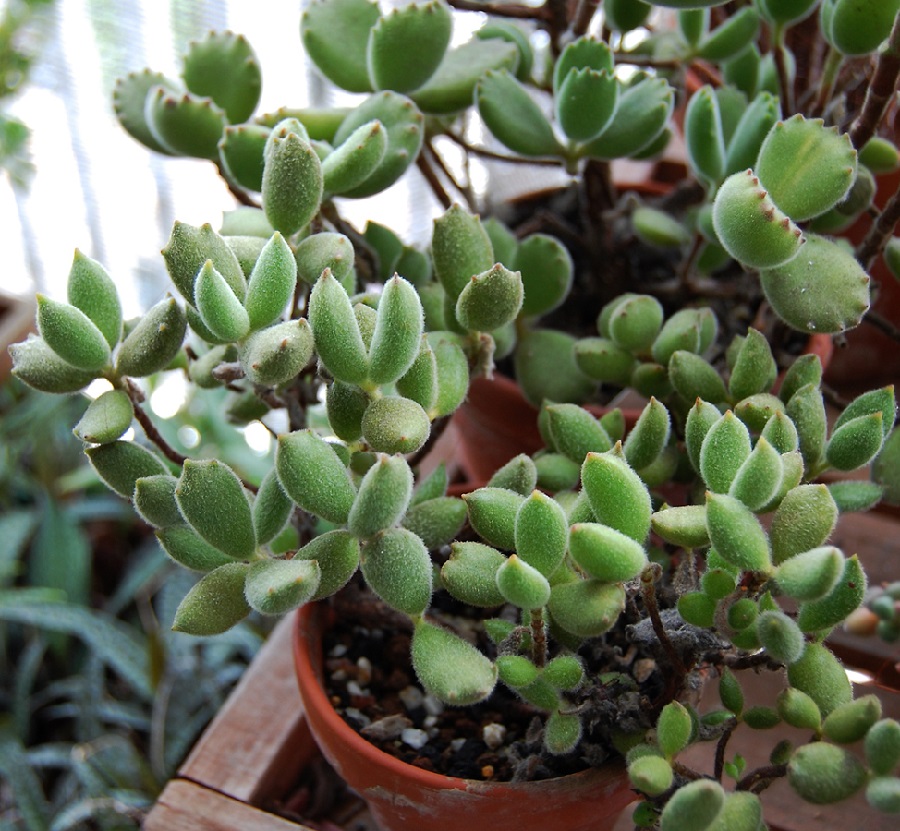
Subsp. ladismithiensis is a rare perennial freely branching succulent shrublet, distinguished from the well-known subsp. tomentosa by comparing the leaves, size of the plant, and orientation of the flower. It has stronger branches and may reach 1 m in height with yellow-green oblong-elliptic or almost cylindrical leaves with few sharp apical teeth.
Its pendulous red flowers resemble those of Cotyledon tomentosa. The stems are 3-4 mm in diameter, loosely set and tomentose to pilose. The inflorescence is a thyrse with 1-3 dichasia having 10-20 nodding florets on a 10-20 cm peduncle covered in dense hairs.
Cotyledon velutina
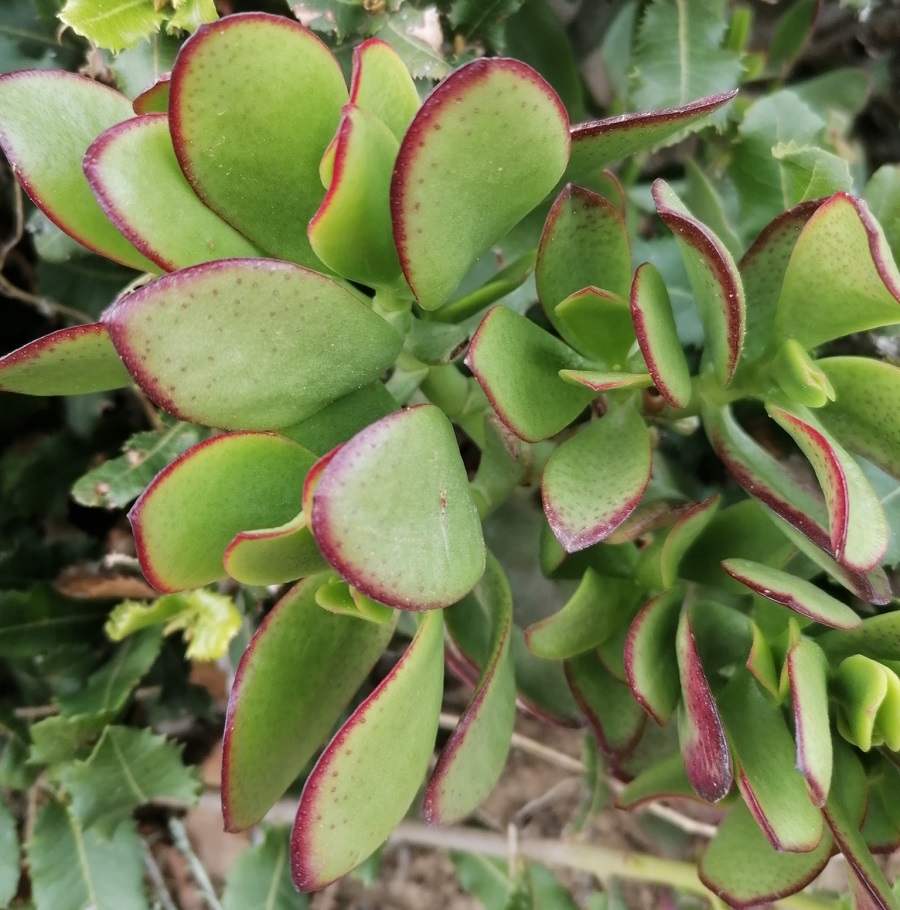
Cotyledon velutina is a branched shrub with opposite leaves, often velvety in texture, and copper-colored or orange flowers that appear in mid-summer. Growing up to 10 feet tall with purplish-brown bark, the oblanceolate leaves may be green to greyish-brown and have reddish margins.
The nodding flowers have five spreading lobes and are bottle-shaped to almost cylindrical. Native to South Africa from Willowmore in Eastern Cape to southern KwaZulu-Natal, it thrives in stony soils associated with larger scrub communities. It is a safe plant for outdoor use.
Cotyledon woodii
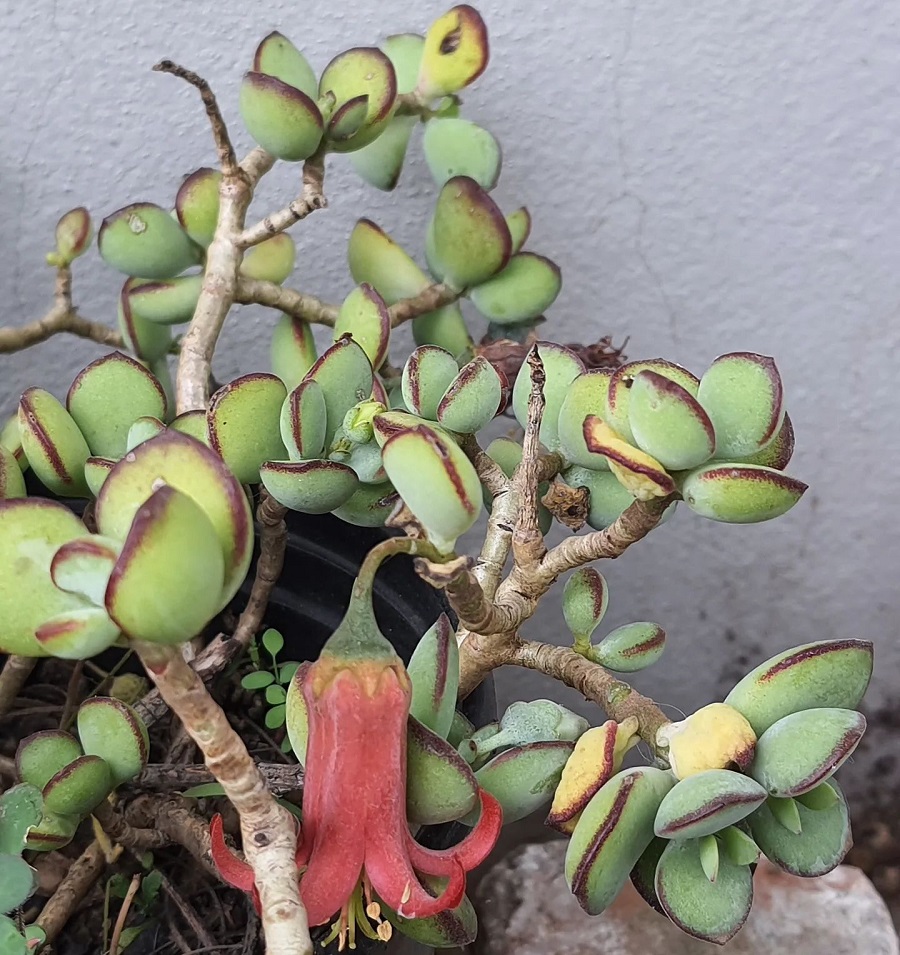
Woodii is a much-branched, succulent shrub found in Valley Bushveld vegetation from the Swartberg Mountains near Ladismith to the former Transkei. It grows up to 1.2 m tall with green, slightly woody branches and light grey-green leaves. The solitary orange or red flowers appear on short inflorescences from December to April and may also flower sporadically year-round.
This species is adapted for hot summers and mild winters, with an average rainfall of 300–500 mm per annum. It was named after British botanist John Medley Wood who first collected it near East London. Variations are cultivated although closely related Cotyledon pendens is distinguished by its growth habit and branched inflorescence.
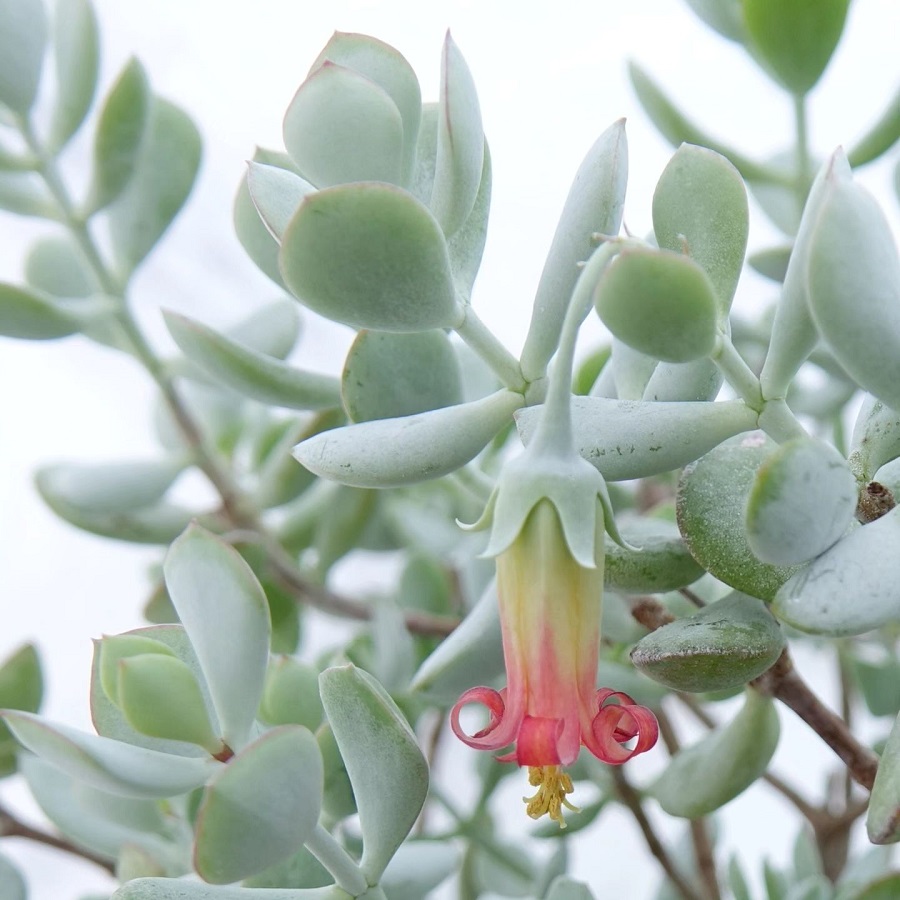
Cotyledon xanthantha
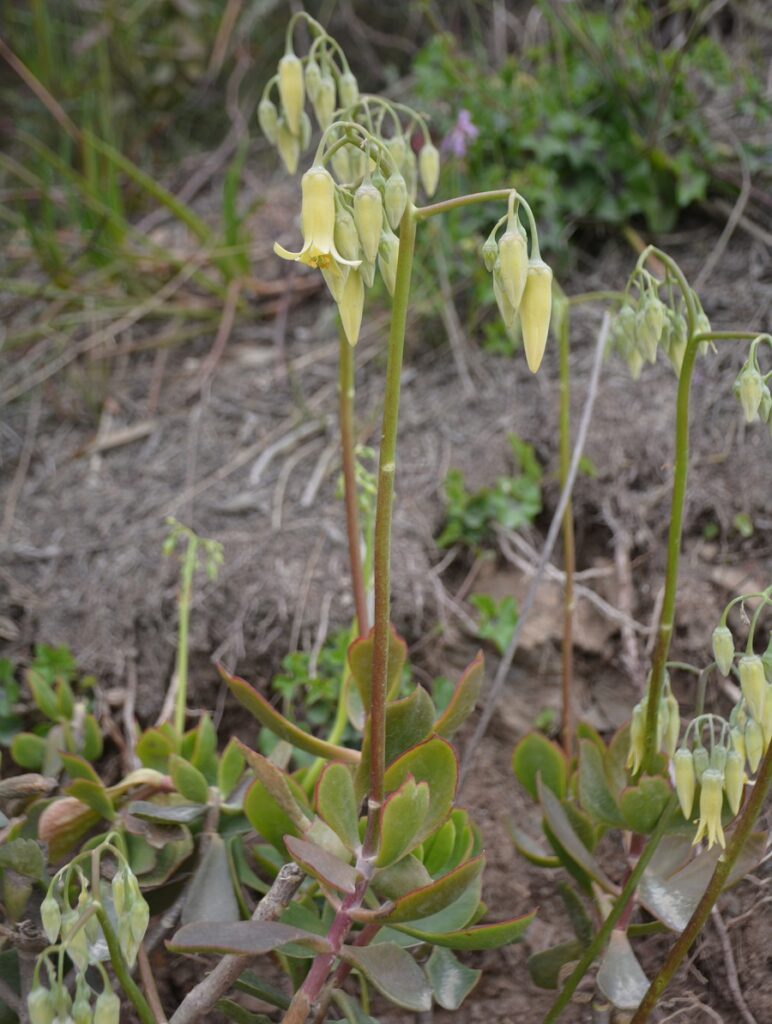
Xanthantha is a recently named, scrambling shrub with tubular yellow flowers found in the dry river valleys of the Still Bay region of the Western Cape. Easily grown, it grows up to 1.5 m tall and has fibrous roots. Its decussate leaves are grey-green, occasionally with a reddish margin. The inflorescence is branched and up to 550 mm long. The tubular flowers are yellow and pendent with lance-shaped lobes that become recurved. It typically flowers from November to December. Commonly known as Still Bay Pig’s Ears, it is one of 12 species of Cotyledon growing in South Africa.
Related Post:
1,000 Types of Succulents [With Pictures]
How To Care For Cotyledon Succulents
Cotyledon succulents are fairly simple to take care of and are a very common choice for houseplants. Not only are their needs easy to figure out, but they are also excellent as decorative plants because of their lovely leaves.
Light
Cotyledon succulents are native to regions where they get tons of natural sunlight. Cotyledon succulents can be grown outdoors or indoors as long as they get some amount of sunlight every single day.
Very direct and intense sunlight in the morning is tolerated well by Cotyledon succulents but direct sunlight in the afternoon can damage the leaves of the plant.
If you have outdoor Cotyledon succulents, then use a sheet to protect the leaves of the plant during the hours of intense sunlight. If you have an indoor plant, then make sure you keep it in a spot that gets partial sunlight throughout the day.
Water
Cotyledon succulents, like most succulents, are extremely sensitive to overwatering but can tolerate underwatering to a reasonable degree. Any amount of excess moisture can lead to the formation of rot in the roots of the plant.
If your Cotyledon succulent is underwatered, you will easily be able to tell. The leaves of the succulent will not have enough water stored and they will become soft to the touch.
In that case, you should go ahead and water the plant. At other times, you must be extremely careful not to overwater the plant. Cotyledon succulents should only be watered if the soil is dry up to a depth of four inches.
Alternatively, if the leaves of the plant are plump, then that means that there is water stored in the plant and you do not need to water the plant.
While watering, you must take care not to put water on the leaves of the plant as that can lead to rotting and damage.
Though this may vary according to climate, you can water your plant once every five to seven days during the summer months.
Cotyledon succulents enter a period of active growth in the winter and need to be watered more heavily during that time.
To know when this period is coming, examine the bottom leaves of the plant. If they are dry, then you need to start increasing the quantity of water.
Soil
Cotyledon succulents have one crucial requirement from the soil. The soil can be of any poor quality but it should be well-drained so that there is no accumulation of moisture around the roots of the plant.
You can buy a pre-made succulent potting mix to plant your Cotyledon succulent or you can make your own by combining regular potting soil, sand and perlite or pumice.
Climate
Cotyledon succulents are native to regions with hot climates and can tolerate high amounts of heat. However, they cannot tolerate low temperatures and can especially die during frost.
Cotyledon succulents should not be kept in temperatures below 45 degrees Fahrenheit for sustained periods of time without protection. Temperatures below 20 degrees Fahrenheit can kill the plant completely.
These succulents, especially those kept outdoors, need to be protected from the frost during the winter months. You can protect your succulent with a sheet during frost.
Fertilizer
Cotyledon succulents can be nourished with fertilizers around once a month during their active growth period. For this, you can use the fertilizers available for succulents by diluting them and then putting them in the soil.
Potting and Repotting
Cotyledon succulents need to be potted in well-drained soil, ideally in a container that has drainage holes.
The roots of the succulent do not take up a lot of space and grow slower than the leaves of the plant. As a result, the plant needs to be repotted only about once every two years. The plant should ideally be repotted in the month of April.
How To Propagate Cotyledon Succulents
New Cotyledon succulent plants can be propagated from the leaves found in the center of the rosettes of the plant. After cutting the leaf, keep it outside for about a day. After that, the leaf can be dipped in a rooting mixture and then potted in a moist soil mixture.
The leaf cutting will soon lead to the growth of rosettes of the succulent. As the rosette grows its own root, it can be transferred out of this soil into well-drained soil that is suitable for Cotyledon succulents.
